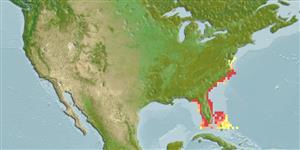>
Cyprinodontiformes (Rivulines, killifishes and live bearers) >
Fundulidae (Topminnows and killifishes)
Etymology: Fundulus: Latin, fundus = bottom; a peculiar name for a topminnow, coined for a bottom species of Atlantic coast being "the abode of the fundulus mudfish" (Ref. 45335).
More on authors: Goode & Bean.
Environment: milieu / climate zone / depth range / distribution range
Ecología
marino; agua dulce; salobre bentopelágico; no migratorio; rango de profundidad 0 - ? m. Temperate; 15°C - 26°C (Ref. 2059); 40°N - 24°N, 85°W - 74°W
Western Atlantic: Chesapeake Bay to southern Florida (including Keys) in USA and northeastern Gulf of Mexico.
Tamaño / Peso / Age
Maturity: Lm ? range ? - ? cm
Max length : 8.0 cm TL macho / no sexado; (Ref. 27139)
Occurs mainly in grassy backwaters and brackish bays, not along open beaches. Also found in fresh water (Ref. 7251). Omnivorous and feeds on small fishes, insects, small crustaceans, plants, annelid worms and mollusks (Ref. 93252). Not a seasonal killifish. Is difficult to maintain in aquarium (Ref. 27139).
Life cycle and mating behavior
Madurez | Reproducción | Puesta | Huevos | Fecundidad | Larva
Distinct pairing during breeding (Ref. 205). Oviparous (Ref. 205). Mature males during the breeding season are dark green, with pearly spots sometimes arranged vertically, these features having similarities with males of F. heteroclitus (Ref. 205). Females are brownish olive in color, with black dots above and black short narrow bars on the body (Ref. 205). Eggs are capable of surviving out of water for long periods of time (Ref. 45994).
Huber, J.H., 1996. Killi-Data 1996. Updated checklist of taxonomic names, collecting localities and bibliographic references of oviparous Cyprinodont fishes (Atherinomorpha, Pisces). Société Française d'Ichtyologie, Muséum National d'Histoire Naturelle, Paris, France, 399 p. (Ref. 27139)
IUCN Red List Status (Ref. 130435)
Threat to humans
Harmless
Human uses
Acuario: Comercial
Más información
Age/SizeCrecimientoLength-weightLength-lengthLength-frequenciesMorfometríaMorfologíaLarvaDinámica larvariaReclutamientoAbundanciaBRUVS
ReferenciasAcuiculturaPerfil de acuiculturaRazasGenéticaElectrophoresesheritabilidadEnfermedadesProcesamientoNutrientsMass conversion
ColaboradoresImágenesStamps, Coins Misc.SonidosCiguateraVelocidadTipo de nataciónSuperficie branquialOtolitosCerebrosVisión
Herramientas
Special reports
Download XML
Fuentes de Internet
Estimates based on models
Preferred temperature (Ref.
123201): 21.1 - 26.9, mean 25.5 °C (based on 105 cells).
Phylogenetic diversity index (Ref.
82804): PD
50 = 0.5000 [Uniqueness, from 0.5 = low to 2.0 = high].
Bayesian length-weight: a=0.00741 (0.00380 - 0.01446), b=3.15 (2.98 - 3.32), in cm total length, based on LWR estimates for this species & Genus-body shape (Ref.
93245).
Nivel trófico (Ref.
69278): 3.2 ±0.2 se; based on size and trophs of closest relatives
Resiliencia (Ref.
120179): Alto, población duplicada en un tiempo mínimo inferior a 15 meses (Preliminary K or Fecundity.).
Fishing Vulnerability (Ref.
59153): Low vulnerability (10 of 100).
Nutrients (Ref.
124155): Calcium = 143 [68, 358] mg/100g; Iron = 0.523 [0.248, 1.058] mg/100g; Protein = 17.1 [15.7, 18.6] %; Omega3 = 0.398 [0.153, 1.021] g/100g; Selenium = 5.25 [1.77, 14.88] μg/100g; VitaminA = 32.1 [8.0, 129.0] μg/100g; Zinc = 1.51 [0.91, 2.41] mg/100g (wet weight);
